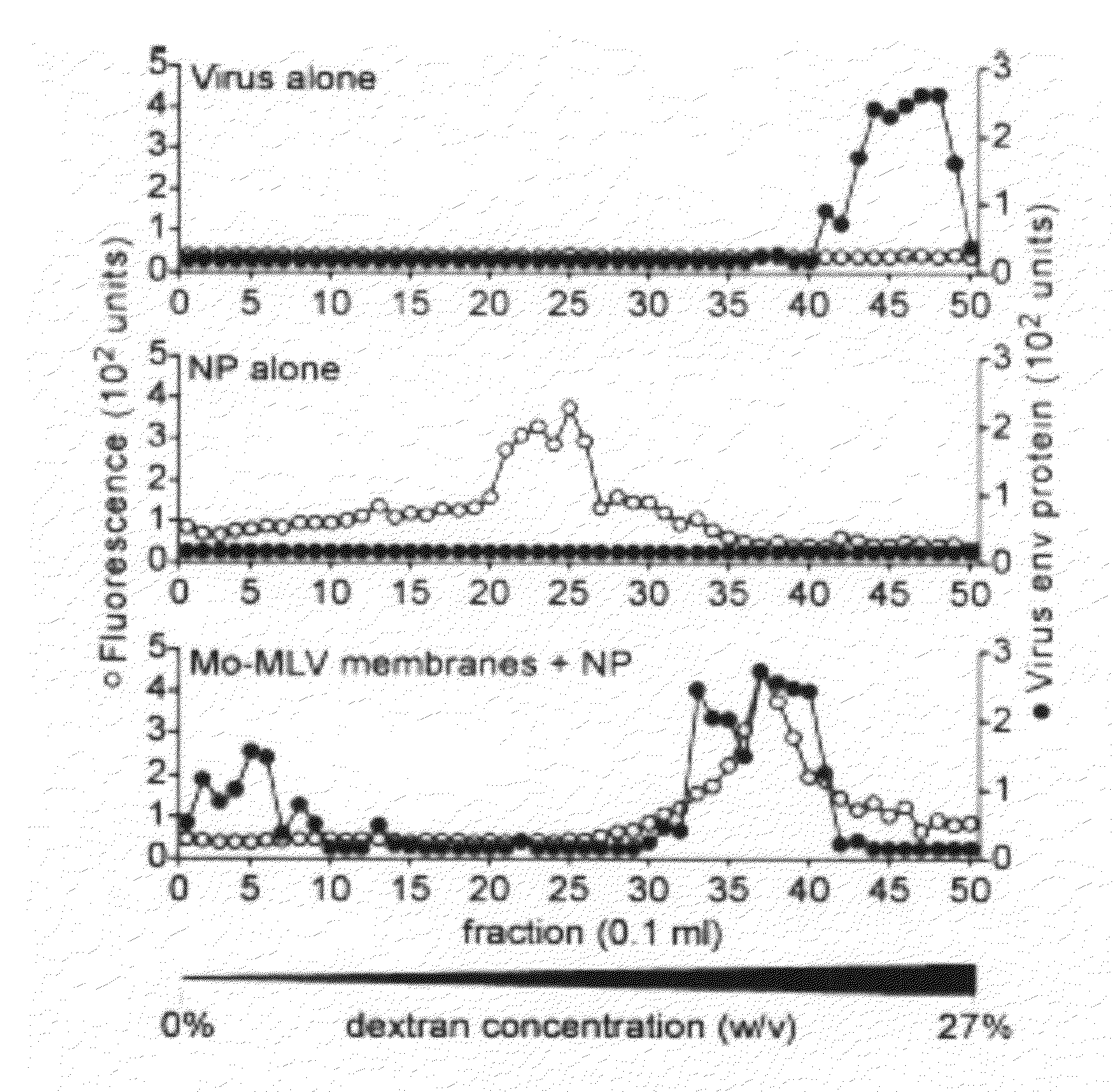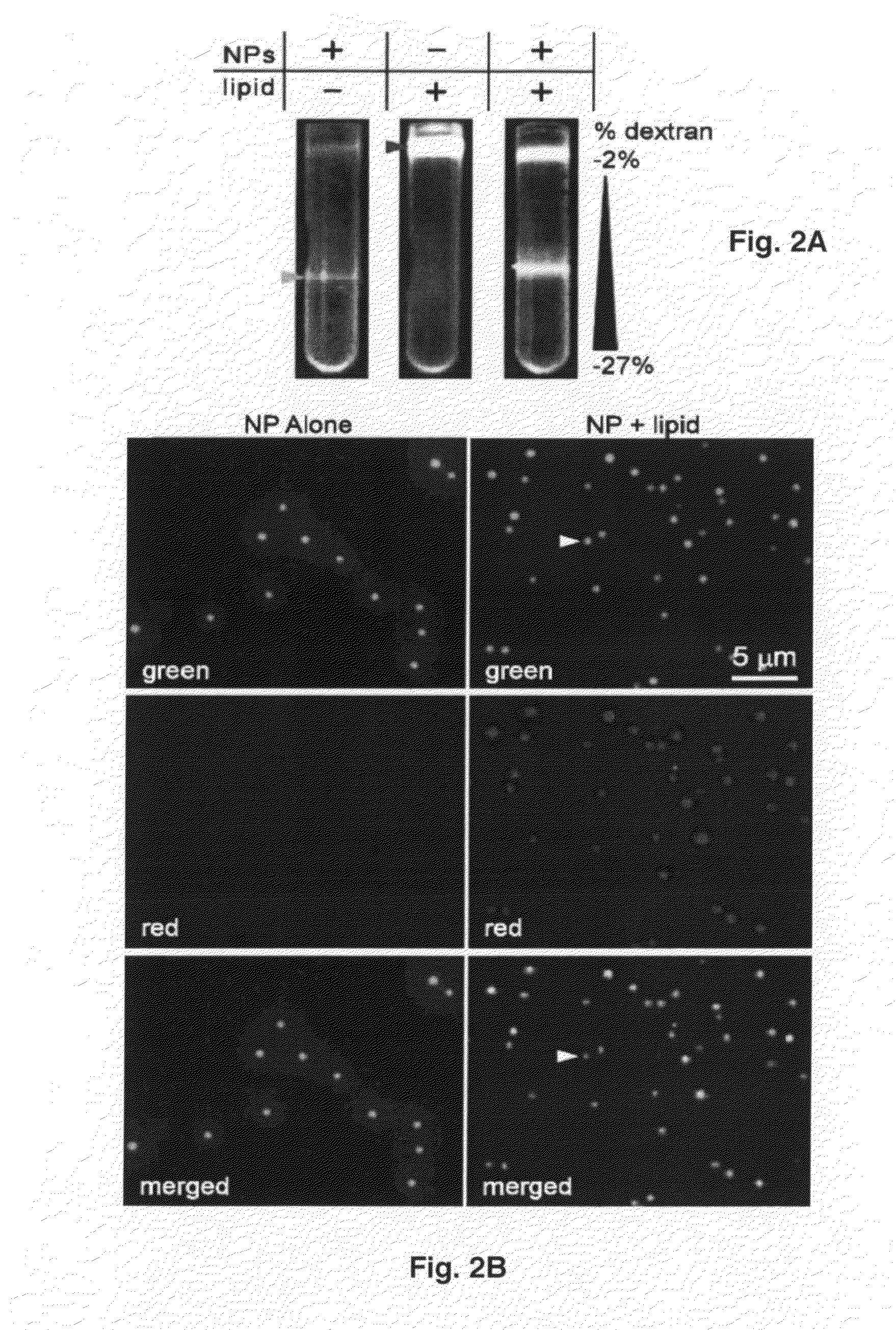Virus coated nanoparticles and uses thereof
- Summary
- Abstract
- Description
- Claims
- Application Information
AI Technical Summary
Benefits of technology
Problems solved by technology
Method used
Image
Examples
example 1
[0064]The Moloney strain of ecotropic Murine Leukemia Virus (Mo-MLV) was collected from CL-1 cells supplied by Dr. J. Cunningham (Harvard Medical School). These cells continually secrete virus into the culture medium. American Type Tissue Culture Collection (ATCC) provided HEK 293 cells. Clones expressing HA-tagged or red fluorescent (mStrawberry)-tagged mCAT-1 were generated by transfection with expression plasmids. Transfected cells were selected by treatment with G418 and colonies were isolated and characterized. GFP-tagged Caveolin expressing cell lines were generated by transfection of expression plasmids followed by selection in blasticidin. For uptake experiments, the GFP-caveolin expressing cells were transiently transfected with the mStrawberry-tagged mCAT-1 expression plasmid and assays were performed 48 hrs later. Expression vectors were pcDNA3 and pLENTI (both from Invitrogen, CA) for mCAT-1 and caveolin, respectively. All cell lines were grown in Dul...
example 2
Nanoparticles
[0065]Fluorescently labeled 100 nm diameter nanospheres were purchased from Invitrogen. Both green fluorescent (yellow-green, excitation 505 nm and emission at 515 nm, #F8803) and blue fluorescent (350 nm excitation and 440 nm emission, #F8797) carboxylate modified nanospheres (2% solids) were used.
example 3
Plasmid Constructs
[0066]The caveolin construct was provided by Dr. Lisa Elferink (University of Texas Medical Branch), and the plasmid encoding the mStrawberry protein was provided by Dr. R. Tsien (University of California at Los Angeles). mStrawberry was cloned into an expression plasmid (pcDNA3) to give an in-frame c-terminal fusion with mCAT-1. For this, the original C-terminal HA-tag was excised with XhoI and ApaI, and was replaced with mStrawberry digested with XhoI and PspOMI restriction endonucleases. The primers used to PCR amplify the mStrawberry gene from the original vector were 5′: GATCTCGAGCGTGAGCAAGGGCGAGGAGAATAACATGG (SEQ ID NO: 1) and 3′: TCAGCGGCCGCTACTTGTACAGCTCGTCCATGCCGCCG (SEQ ID NO: 2). The XhoI endonuclease site used for attachment to mCAT-1 is underlined.
PUM
| Property | Measurement | Unit |
|---|---|---|
| Pore size | aaaaa | aaaaa |
| Pressure | aaaaa | aaaaa |
| Composition | aaaaa | aaaaa |
Abstract
Description
Claims
Application Information
 Login to View More
Login to View More - R&D
- Intellectual Property
- Life Sciences
- Materials
- Tech Scout
- Unparalleled Data Quality
- Higher Quality Content
- 60% Fewer Hallucinations
Browse by: Latest US Patents, China's latest patents, Technical Efficacy Thesaurus, Application Domain, Technology Topic, Popular Technical Reports.
© 2025 PatSnap. All rights reserved.Legal|Privacy policy|Modern Slavery Act Transparency Statement|Sitemap|About US| Contact US: help@patsnap.com



